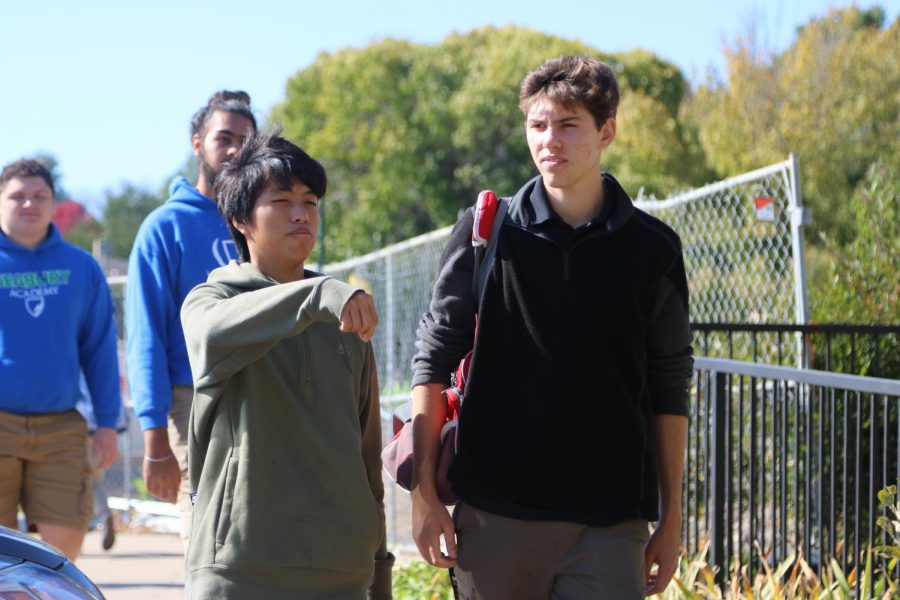Quantity or Quality
Adjusting to a shrunken Seabury
More stories from Diego Klish
Juniors Bruce Xu and Brayden Shumaker fight for sidewalk space. The students were forced to fight for their space on the sidewalk due to crowding from the vehicles and bushes on opposing sides of the path.
This year, with all of the new adjustments to the school, including closed-off entrances and faculty member Michael Pulsinelli’s exile to the land of the portables, students have been forced to adjust to a number of different challenges on their daily commute to and from classes.
The problem begins with the sheer distance between classes. Last year the distance between the commons and Pulsinelli’s room was approximately forty-six steps, whereas this year the distance is five times as great at approximately two hundred and sixty-five steps. At first, this does not seem like a major issue, but when it comes to seniors who go up and down the path, the distance can become sizable. Along with this, students who would normally cross directly through the commons to the computer lab must now loop around through the school if they have a problem with an iPad and such. But this is not even the beginning of the problems sowed by the constricting and rearranging of the school.
Senior Emily Ice, however, has a very positive approach towards the increase in daily walking: “I do notice the walk, and I have to go back and forth about three times a day, but my leg muscles are swole!”
On the flip side, sophomore Ryan Dekat, also known as “VIP”, has a very different view of the walking. “I definitely do notice the walk each day,” says Dekat, “and when I do forget things it’s no longer a quick walk back, and I have to go back and forth sometimes four or five times a day. It honestly can be very frustrating sometimes.” And Dekat has a point; for some students, this can be an actual issue and can sometimes lead to being late to classes or signing in for open hours.
Sophomore Maisy Rader looked more into the future and what problems could come about as the weather changes: “I feel like right now the walk really isn’t that big of a deal, but in the future, as the months get colder, I think the walk can start to become formidable, especially for people who refuse anything other than shorts.” This is obviously something that cannot be avoided, but one of the upsides and reasons for the new school is that this problem will be avoided because all walking between classes will be inside.
Next up are the sidewalks. Where they were once five feet wide, they now are restricted to two feet in many areas due to, among others, two particular cars who are already notorious for taking up space. Rather than parking more conservatively and allowing for students to walk both ways, they choose to instead come up as far as possible, restricting the access of one small child to walk abreast on the once spacious sidewalk. The resulting effect is shoving of persons, elbows to the gut and pushing through the bottlenecked crowd in order to survive the countdown clock until class begins. The path only allows for one person at a time and results in a constant switch of traffic causing what would take ten seconds to sometimes take two minutes. For many unsuspecting sixth graders at elbow level, any trip across the sidewalk may prove to be their last.
The next problem this year is that every two weeks, the lunch table assignments list is placed such that a crowd congregates around it. “They are right in the main thoroughfare through which literally every student has to walk,” says senior Malcolm Maude. On top of this, the faculty is trying to get out of the teachers’ lounge at the same time, which creates even more human traffic.
Granted, these problems are not the worst thing to ever happen to Seabury. “It may be the biggest problem the school has ever faced,” says Maude sarcastically, “and is a critical difficulty we should fix, otherwise we might all die.” While this obviously is not a huge issue, it is good to be aware of these problems, and while we adapt to the new school, we can still try to make improvements. For example, as students were being interviewed about this issue, faculty member Betsy Alford listened in and decided to move the lunch table assignments list into the gym to try to prevent traffic jams. While complaining about these problems is not very productive, addressing them is and will often lead to better solutions.
